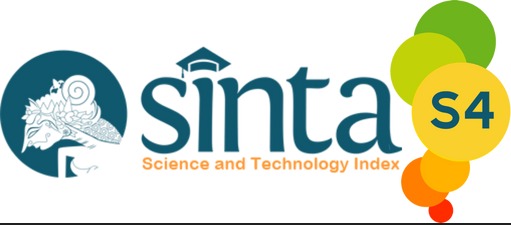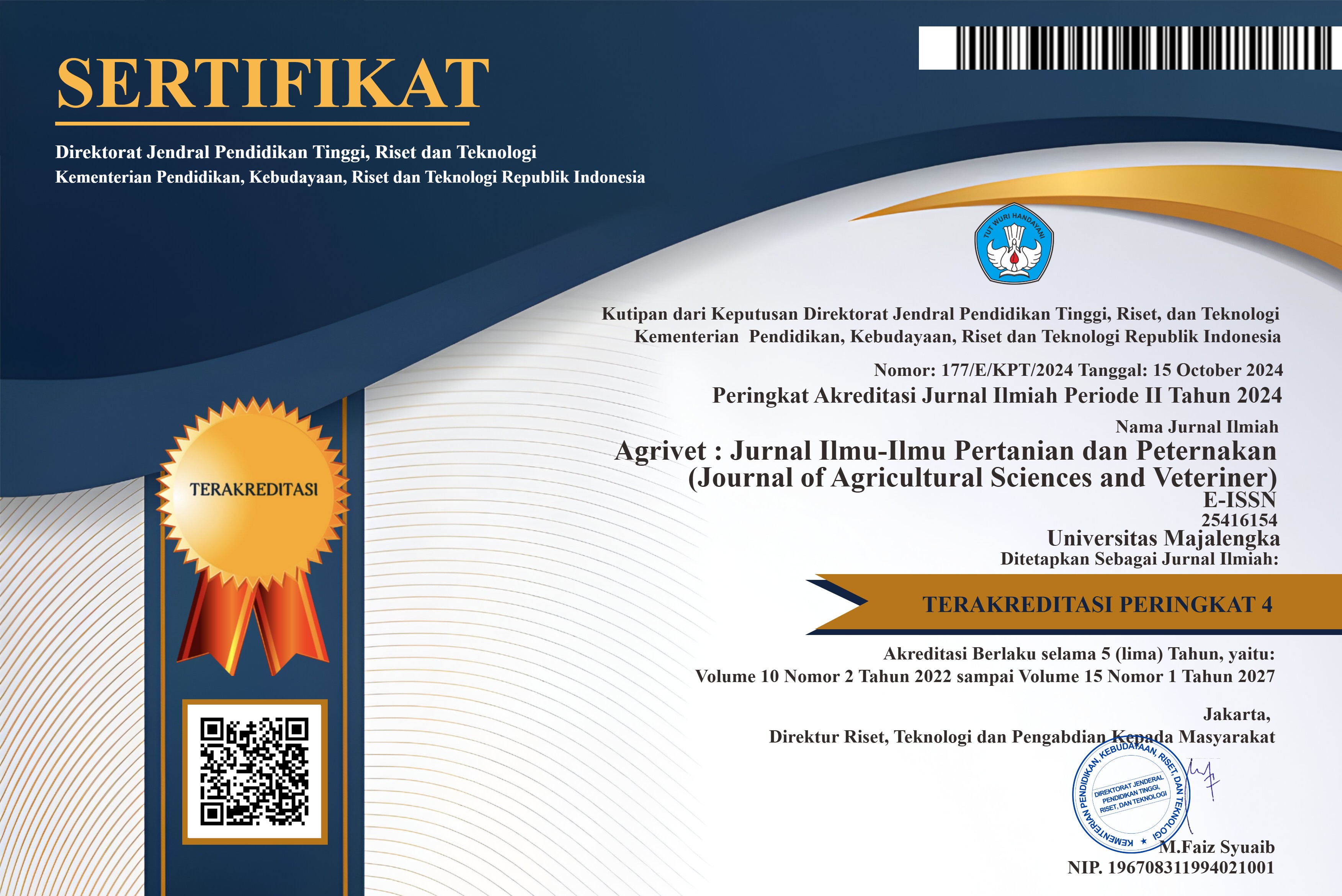Performa, bobot karkas, dan lemak abdominal ayam broiler yang diberi dedak fermentasi menggunakan ragi tape (Saccharomyces cerevisiae)
DOI:
https://doi.org/10.31949/agrivet.v11i2.7214Abstract
This study aimed to determine the growth of the carcass weight and abdominal fat of broiler fed fermented rice bran using tape yeast (Saccharomyces cerevisiae). This study was carried out in the poultry production shed of the Animal Husbandry Study Program, Faculty of Agriculture, University of Khairun, located in Fitu Village, South Ternate City. One hundred of DOC broiler which consisted of using a Completely Randomized Design (CRD) which concicted of 5 treatments and 4 replications, namely R0 = basal feed (control), R1 90% basal feed + 10% fermented rice bran, R2 = 80% Basal feed + 20% fermented rice bran, R3 = 70% basal feed +30% fermented rice bran, R4 = 60% basal feed + 40% fermented rice bran. The variables observed included ration consumption, body weight gain, carccas weight and abdominal fat. The results showed that the administration of fermented bran using tape yeast (Saccharomyces cerevisiae) showed no significant difference to feed consumption (P>0.05), but body weight gain, feed conversion showed, carcass weight and abdominal fet significant differences (P<0.05). The results of the study can be concluded that giving up to 20% fermented bran can increase the growth of broiler chickens.
Keywords:
Yeast tape, bran, fermentation, carcass, abdominan fat, broiler chickensDownloads
References
Ahmad, R. Z. 2005. Pemanfaatan Khamir Saccharomycescerevisiae untuk Ternak.Wartazoa 15 (1):49-55
Ashayerizadeh, A., B. Dastar, M. S. Shargh, M. Sadeghi, S. Zerehdaran. 2017. Fermented rapeseed meal is effective in controlling Salmonella enteric serovar Typhimurium infection and improving growth performance in broiler chicks. Vet. Microbiol. 201. 93–102
Anggoro, L., Wahyuni, H. I., & Widiastuti, E. 2019. Pengaruh Pemberian Kulit Pisang Fermentasi dengan Chrysonilia Crassa dan Bacillus Subtilis terhadap Bobot Relatif Organ Pencernaan Ayam Broiler Doctoral dissertation, Faculty Of Animal And Agricultural Sciences.
Enga, Rambu Enga, Sabarta Sembiring dan I Made Suaba Aryanta. 2015. Pengaruh lama fermentasi dengan Saccharomyces cerevisiae terhadap kandungan asam amaino dan kecernaan energi tepung biji asam sangria sebagai pakan suplemen induk babi bunting. Jurnal Nukleus Peternakan (Juni 2015), Volume 2, No. 1:23-31.
Gaspersz, V. 1995. Teknis Analisis Dalam Penelitian Percobaan Jilid I. Penerbit Tarsito Bandung. Hal. 62-111 Gaspersz, V. 1995. Teknis Analisis Dalam Penelitian Percobaan Jilid I. Penerbit Tarsito Bandung. Hal. 62-111.
Herlina, B., Novita, R., & Karyono, T. 2015. Pengaruh Jenis dan Waktu Pemberian Ransum terhadap Performans Pertumbuhan dan Produksi Ayam Broiler. Jurnal Sain Peternakan Indonesia, 10(2), 107-113
Hanafi, N.D. Tafsi, M, Sitindaon, S.H. Sadeli, A, Simanungkalit, K. 2022. Pengaruh Penggunaan Bungkil Inti Sawit Taraf 40% dalam Ransum terhadap Bobot Potong, Karkas, Potongan Komersil Karkas dan KualitasDaging Ayam SenSi-1 Agrinak. Jurnal Agripet. Vol. 22(1) : 62-71.
Hubulo,C., Saleh, E. J., & Djunu, S. S. (2022). Uji Performa Ayam Kampung Unggul Balitnak Menggunakan Formula Pakan Lumpur Sawit Terfermentasi. Jambura Journal of Animal Science, 4(2), 133–139
Mide, M.Z. 2007. Konversi Ransum dan Income Over Feed and Chick Cost Broiler yang Diberikan Ransum Mengandung Berbagai Level Tepung Rimpang Temulawak (Curcumin Xanthorrhiza Roxb). Buletin Nutrisi dan Makanan Ternak.6(2): 21-26
Mursye N. Regar, Youdhie H.S. Kowel dan Merci R. Waani. 2019. Persentase Karkas dan Lemak Abdomen Broiler yang diberi Pakan Kombinasi Herbal dengan Mineral Zink. Jurnal Zootec. Vol.39. No. 2: 505-510.
Mahardika, N. S., Savitri, D. A., & Rusdianto, A. S. (2019). Pembuatan Pakan Ternak Fermentasi dan Penerapan Zero Waste Sebagai Upaya Pemberdayaan Peternak Ayam Broiler di Kabupaten Bondowoso. UNEJ e-Proceeding.
Soeharsono. 2010. Probiotik. Basis Ilmiah, Aplikasi, dan Aspek Praktis. Widya Padjadjaran. Bandung
Sio, A. K., Nahak, O. R., & Dethan, A. A. 2016. Perbandingan Penggunaan Dua Jenis Ransum terhadap Pertambahan Bobot Badan Harian (PBBH), Konsumsi Ransum dan Konversi Ransum Ayam Broiler. Jurnal Of Animal Science (JAS) 1(1), 1-3.
Saelan, E, Sulasmi, Utami, S, dan Salim, A. Performa Ayam Kampung Unggul Balitnak (KUB) dengan Penambahan Dedak Fermentasi dalam Ransum. Agrivet. Jurnal Ilmu Pertanian dan Peternakan. Vol.11. No.01. Hal. 7-12.
Wahono, S. Krido, Damayanti,E., Rosyid,V. T dan Sadyastuti, E. I. 2011. Laju Pertumbuhan Saccharomyces Cerevisiae Pada Proses Fermentasi Pembentukan Bioethanol Dari Biji Sorgum (Sorghum bicolor L.). Seminar Rekayasa Kimia dan Proses. Jurusan Teknik Kimia. Fakultas Teknik Universitas Diponegoro, Semarang. ISSN: 1411-4216
Wibawa A.A.P., Wirawan I W., dan Partama I. B. G. 2015. Peningkatan Nilai Nutrisi Dedak Padi Sebagai Pakan Itik Melalui Biofermentasi dengan Khamir. Majalah Ilmiah Peternakan. Vol. 18 No.1. Hal. 11-16
Wulandari, W., Santi, S., & Mahmud, A. T. B. A. (2021). Analisis Kandungan Nutrisi Pakan Ternak Fermentasi Berbahan Dasar Daun Jati (Tektona grandis) dengan Lama Fermentasi yang Berbeda. Agrovital: Jurnal Ilmu Pertanian, 6(2), 70-74.
Published
How to Cite
Issue
Section
License
Copyright (c) 2023 Emy Saelan Emy

This work is licensed under a Creative Commons Attribution-ShareAlike 4.0 International License.
An author who publishes in the Jurnal Agrivet agrees to the following terms:
- Author retains the copyright and grants the journal the right of first publication of the work simultaneously licensed under the Creative Commons Attribution-ShareAlike 4.0 License that allows others to share the work with an acknowledgment of the work's authorship and initial publication in this journal
- The author is able to enter into separate, additional contractual arrangements for the non-exclusive distribution of the journal's published version of the work (e.g., post it to an institutional repository or publish it in a book) with the acknowledgment of its initial publication in this journal.
- The author is permitted and encouraged to post his/her work online (e.g., in institutional repositories or on their website) prior to and during the submission process, as it can lead to productive exchanges, as well as earlier and greater citation of the published work












